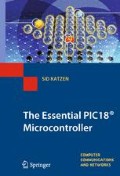Abstract
The majority of medium- and long-range digital communication involves serial data streams.
This chapter discusses both synchronous and asynchronous protocols; including SPI and IIC, with reference to the Enhanced Universal Synchronous Asynchronous Receiver Transmitter (EUSART) and Master Synchronous Serial Port (MSSP) modules. Also covered are networking and electrical characteristics.
Access this chapter
Tax calculation will be finalised at checkout
Purchases are for personal use only
Notes
- 1.
All data outputs are simultaneously available and thus the 74HCT164 is best described as a serial-in parallel-out (SIPO) register as well as a SISO shift register.
- 2.
I have used this name as we shall see, there is a built-in function called spi_write().
- 3.
See Fig. 11.12 in my The Quintessential PIC ® Microcontroller.
- 4.
SPI™ is a trademark of Motorola/Freescale, Inc.
- 5.
Microwire™ is a trademark of National Semiconductor Corporation.
- 6.
Some of which are in the Status register due to lack of space!
- 7.
I2C™ is a trademark of the Philips/NXP Corporation.
- 8.
- 9.
By the I2C-bus committee.
- 10.
In older PIC18 devices, and also the PIC18F1X20, BF is cleared in this event and it is not necessary to read the SSPBUF to clear it. See App. Note AN734B for further details.
- 11.
In older PIC18 devices \(\mathsf{R}/\overline{\mathsf{W}}\) was cleared.
- 12.
Literally a “typewriter from afar”; Greek, tele = far.
- 13.
Strictly speaking the baud rate is a measure of information flow. For a simple baseband system this is equal to the bit rate. However, this equality is not always true. For instance, a telephone modem can use a di-bit modulation scheme where groups of bits two at a time give a carrier tone phase shift of 0°, 90°, 180°and 270°for the patterns 00, 01, 10, 11, respectively. In this case the baud rate is twice the bit rate.
- 14.
Actually the first documented binary coded alphanumeric code was devised by Francis Bacon in around 1600. It too was a 5-bit code.
- 15.
Newer versions of the assembler use 32-bit arithmetic for label arithmetic.
- 16.
Sometimes known as the asynchronous communication interface adapter, or ACIA.
- 17.
See The Quintessential PIC ® Microcontroller, Chap. 12, by the author for more details.
- 18.
Exceptionally, the 18-pin footprint devices, such as the PIC18F1X20, use RB1 and RB4 for TX and RX respectively.
- 19.
See http://www.lin-subbus.org for more details.
- 20.
Or sometimes ignorance!
- 21.
Defined in the United States of America as the Electronics Industries Association EIA 232-E standard and in Europe as the V24 interface, by the CCITT.
- 22.
1-Wire® is a registered trademark of Maxim Integrated Products Inc.
- 23.
For more details, see Microchip’s application note AN1199 1-wire ® Communication with PIC ® Microcontroller.
- 24.
See http://www.roundsolutions.com/techdocs/index.php for more details.
Author information
Authors and Affiliations
Corresponding author
Rights and permissions
Copyright information
© 2010 Springer-Verlag London Limited
About this chapter
Cite this chapter
Katzen, S. (2010). One Bit at a Time. In: The Essential PIC18® Microcontroller. Computer Communications and Networks. Springer, London. https://doi.org/10.1007/978-1-84996-229-2_12
Download citation
DOI: https://doi.org/10.1007/978-1-84996-229-2_12
Publisher Name: Springer, London
Print ISBN: 978-1-84996-228-5
Online ISBN: 978-1-84996-229-2
eBook Packages: Computer ScienceComputer Science (R0)

